
Having spent a few days exploring the city of Gwalior in Madhya Pradesh, it was time to explore some of the sites that lie outside of the city on a number of day excursions. First on my list was Gohad Fort, located 45km north-east of Gwalior on the route to Bhind.
I’ve failed to find much in the way of documentation about the fort, all the information that follows (which seem to concur with each other) has been gleaned from a handful of websites. This blog will be light on text and heavy with photography :-).
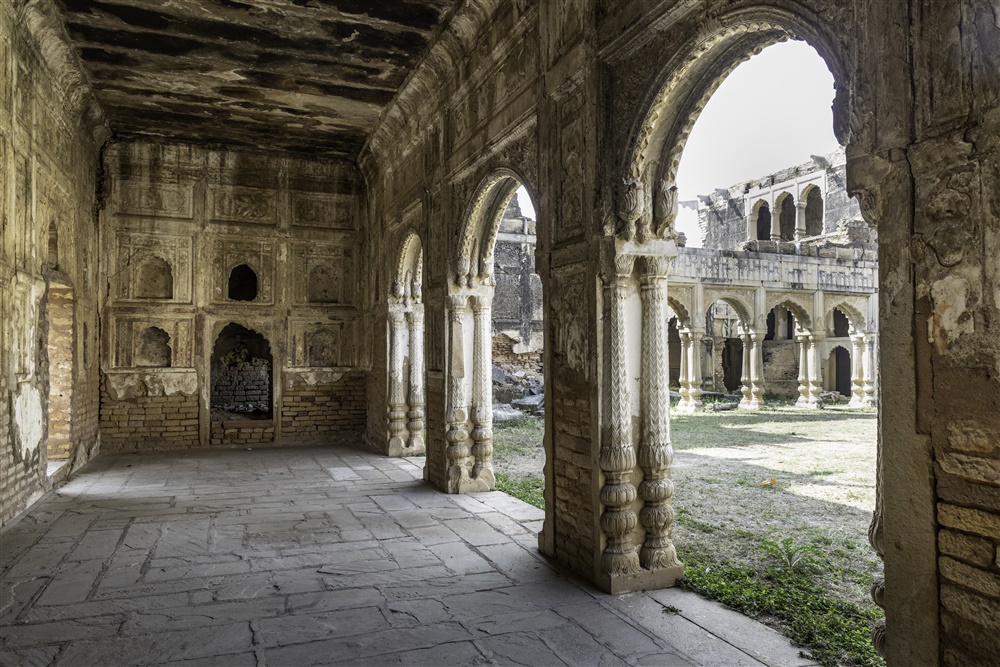
It’s safe to say that Gohad Fort is well and truly off the tourist trail. Having found the guard to unlock the gates and let me in, I had the entire fort to myself for over two hours. I definitely got the sense that hardly anyone ever comes here.

There is no signage in the fort to help you interpret the ruins, there’s not even any paths to speak of. It’s as if the last person left the fort some 300 years ago and since then the entire place has been forgotten about. Some of the areas I would think are actually quite dangerous now to explore, but there’s nothing preventing you from doing so.

Everywhere you look there is evidence of just how spectacular this fort must once have been; the carvings, plaster work and scale of some some of these buildings is impressive even in their dilapidated state.

I confess I do actually really enjoy visiting sites like this, having an entire fort to explore by yourself is (by western standards) pretty unusual, and the imagination can run riot trying to figure out what these buildings were for and how it must have been like to live here.
It is documented that the following buildings reside within the fort complex; Navin Mahal, Khās Mahal, Shish Mahal, Sāt-Bhānwar, Deoghar, Khās Darbār, Ām Darbār, Bhandār Grih and Rāni Bāgh. There are also the temples of Rāma Jānaki, Laxman, Rādhā Krirshna, Shiva and Markandeshwar. You are all welcome to try and place the photograph to the building…
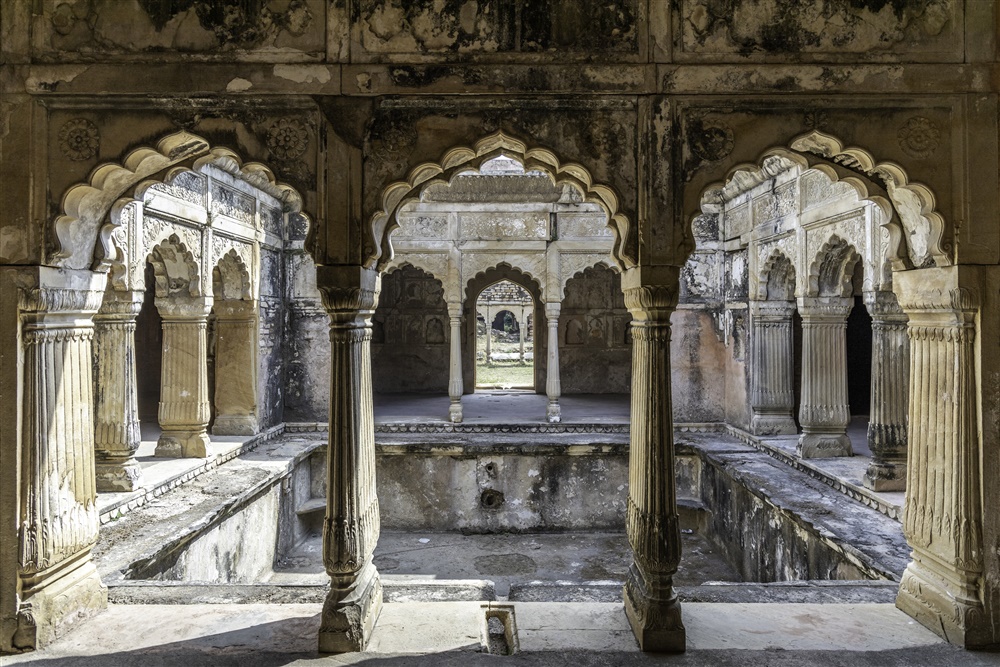
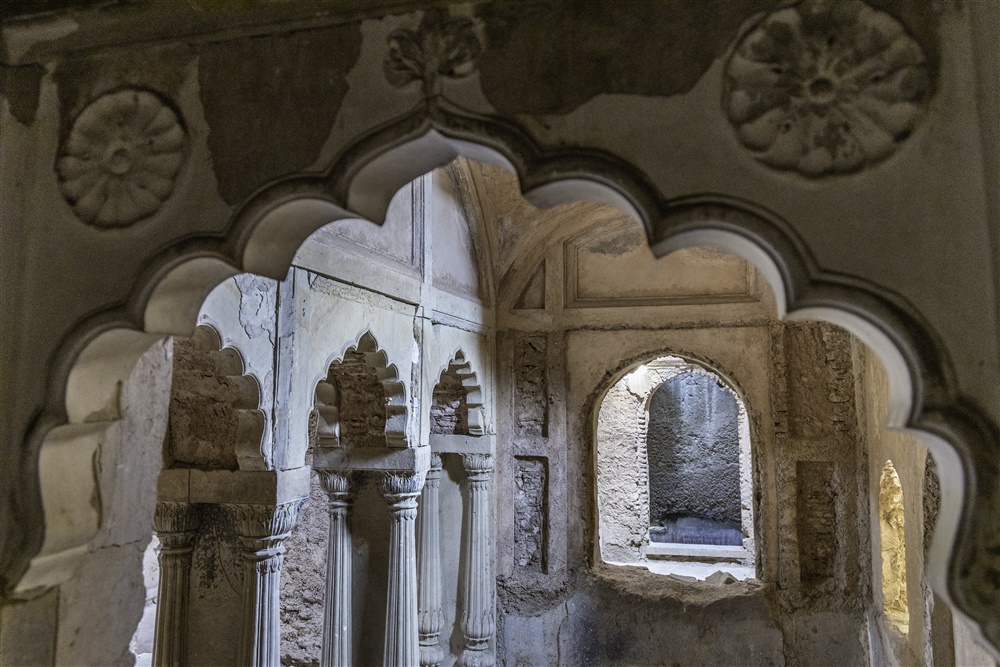
According to William Cook and Alexander Cunningham, the people of the Jat caste from a village near Agra (Bamrauli) settled the town of Gohad in 1505, and subsequently developed the area into an important Jat stronghold.
The fort itself was founded by the Jat ruler Singhandev II shortly after 1505, but the majority of the construction was undertaken by Maharaja Bhim Singh Rana, Maharaja Chhatra Singh Rana and Kirat Singh Rana. It is considered the most important of the 350 forts and defensive structures that were built in the region around Gohad to protect their people.
As is the case with every fort that is built, exactly where it is placed in the landscape is key. In this case, Gohad Fort was built by a prominent bend in the river Vaisali, and the river was augmented (excavated and reshaped) further to ultimately provide an excellent first line of defense around half of the circular fort.

The rampart extends for 5km around the fort, and has seven gates that were named after the settlements the trackways would lead to; Itayli, Barthara, Gohadi, Birkhari, Kathwan, Kharaua and Saraswati.

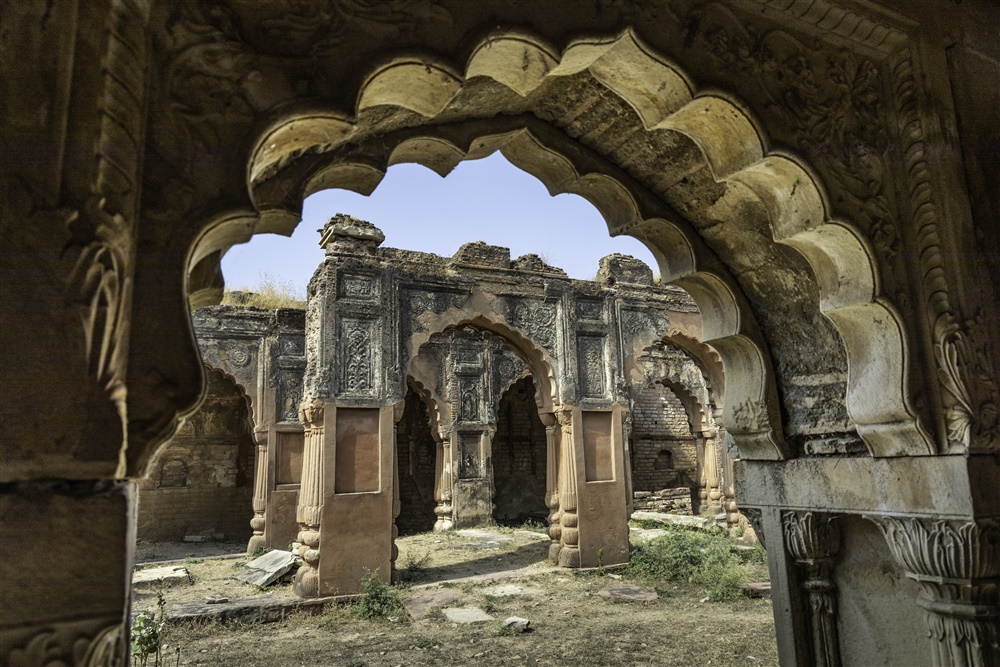
I sometimes wonder if places like this are a missed opportunity for Indian tourism. Gwalior is vastly underrated and overlooked in my opinion with regards to tourism, and whilst it receives quite a lot of visitors due to its close proximity to Agra, there’s no real emphasis on the heritage locations both within the city and in the surrounding countryside. I guess as always it all boils down to budgets and resources.
Since visiting Gohad Fort I have discovered that in 2017 it was certified by UNESCO in their “Honorable List”, and a fund of 7,000,000 rupees (£77,500 or $101,200) was donated to help with the restoration of the fort and its gates. This is encouraging news, and may explain some activity I witnessed outside the main fort.
Opposite the entrance to the fort is a large structure that does appear to be of similar age to some of the buildings inside the fort. It must be some sort of palace, but I don’t know the name of it and google maps doesn’t give any clues. Renovation work is currently underway on this structure, so perhaps this will eventually extend to the fort proper in due course.
Please ‘Like’ or add a comment if you enjoyed this blog post. If you’d like to be notified of any new content, just sign up by clicking the ‘Follow’ button. If you have enjoyed this or any other of my posts, please consider buying me a coffee. There’s a facility to do so on the righthand side of this website for desktop users, and just above the comment section for mobile users. Thank you !
If you’re interested in using any of my photography or articles please get in touch. I’m also available for any freelance work worldwide, my duffel bag is always packed ready to go…
KevinStandage1@gmail.com
kevinstandagephotography.wordpress.com
Categories: Gohad Fort, India, Madhya Pradesh




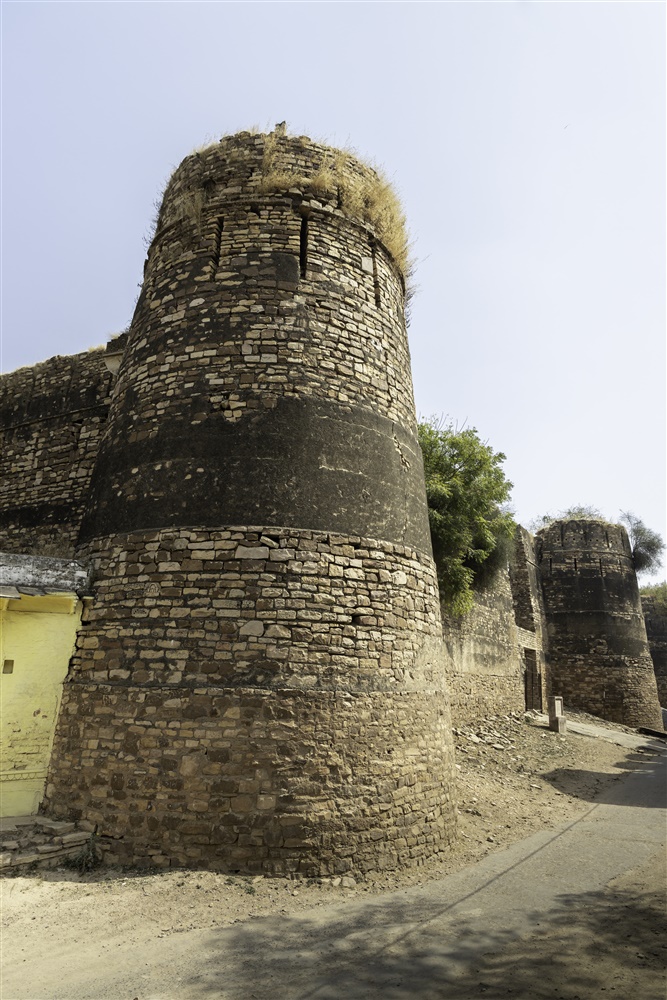
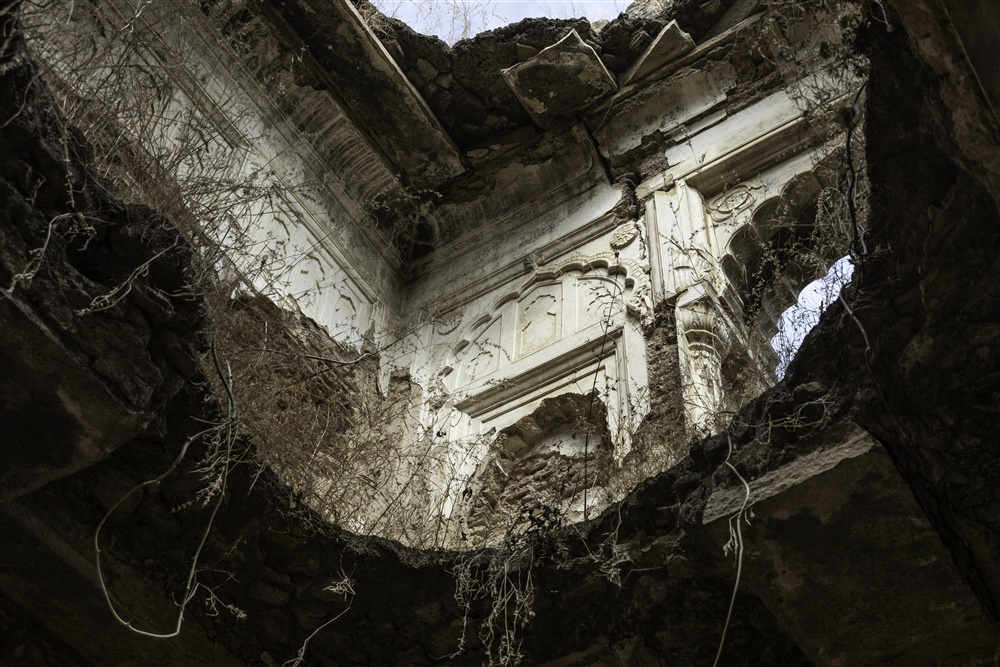

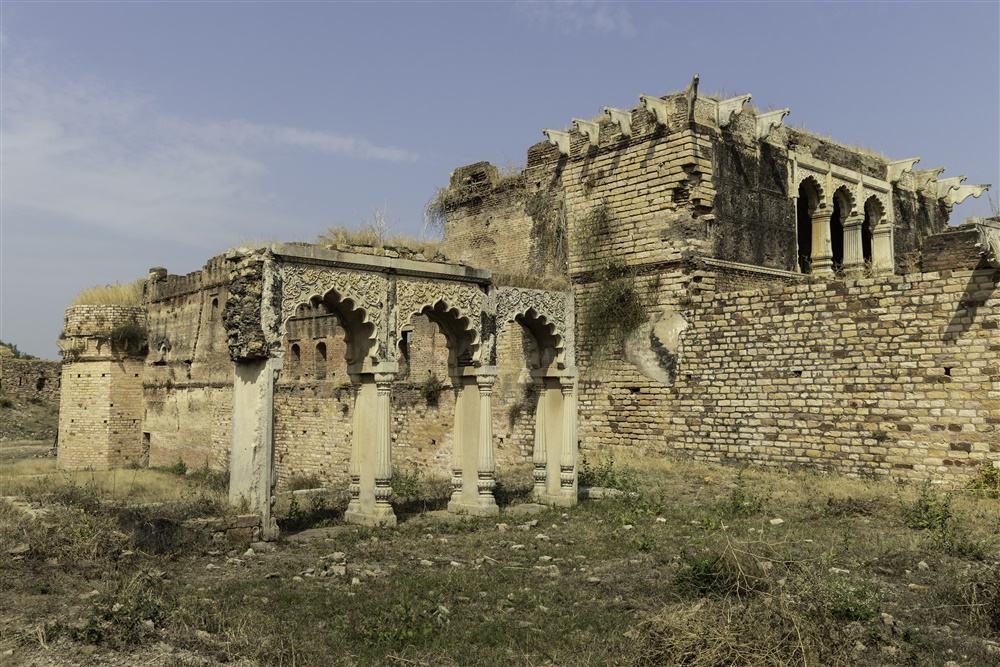

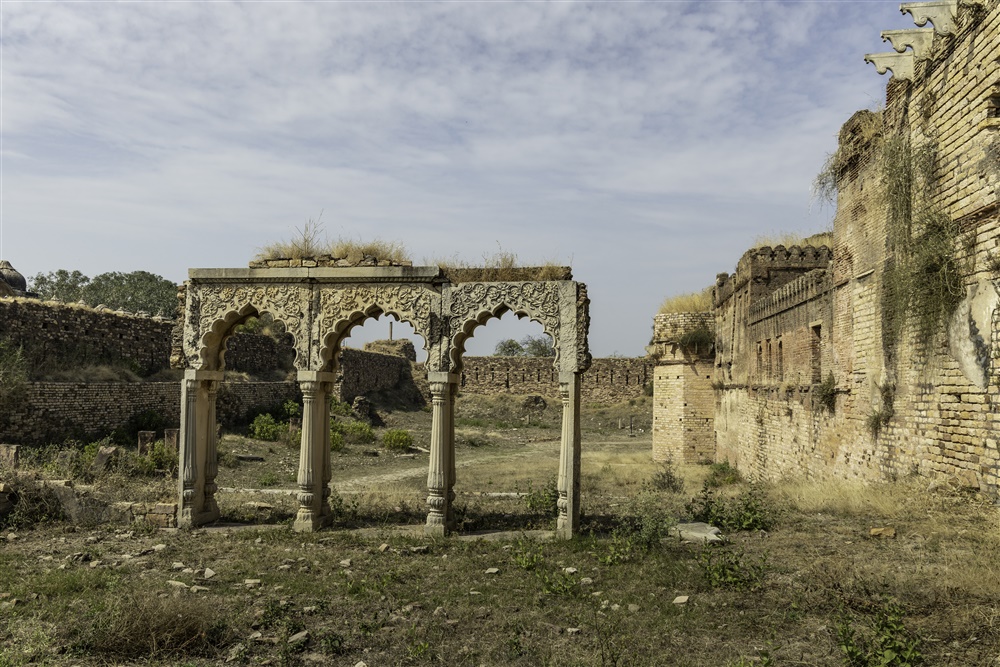
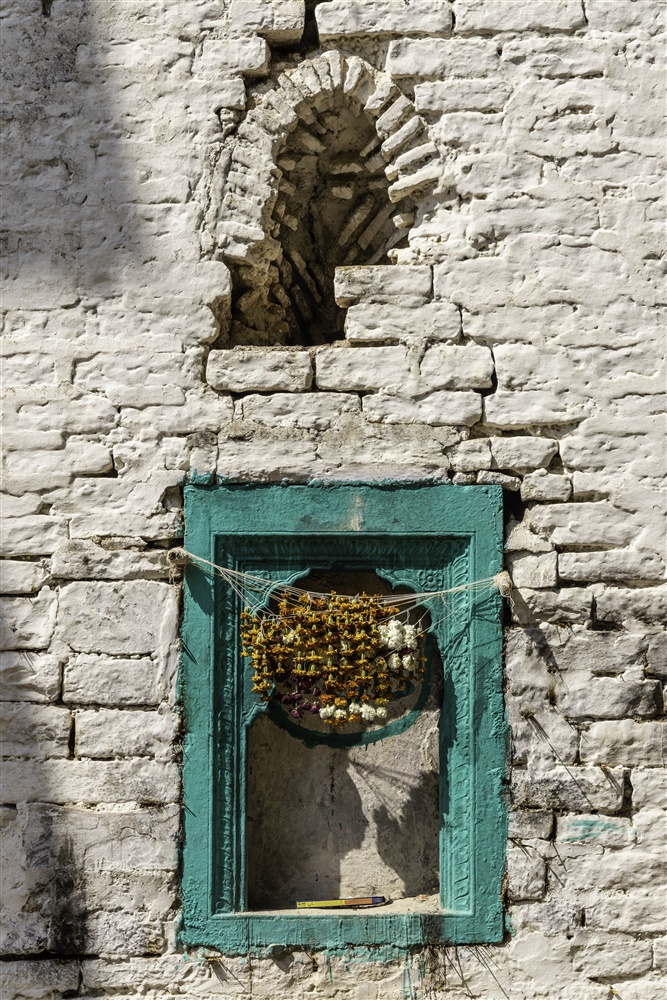

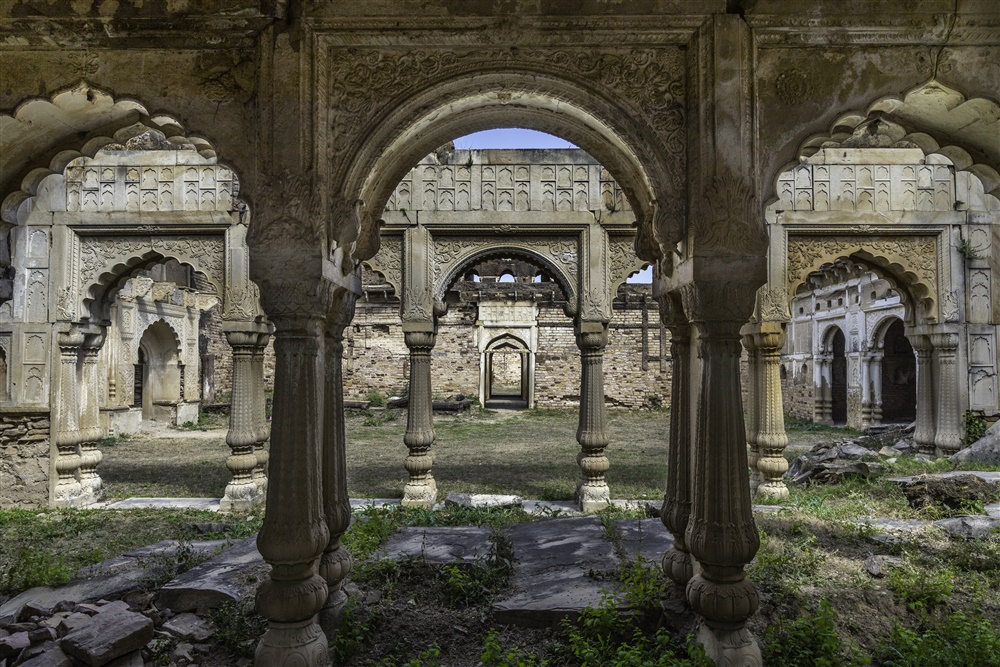

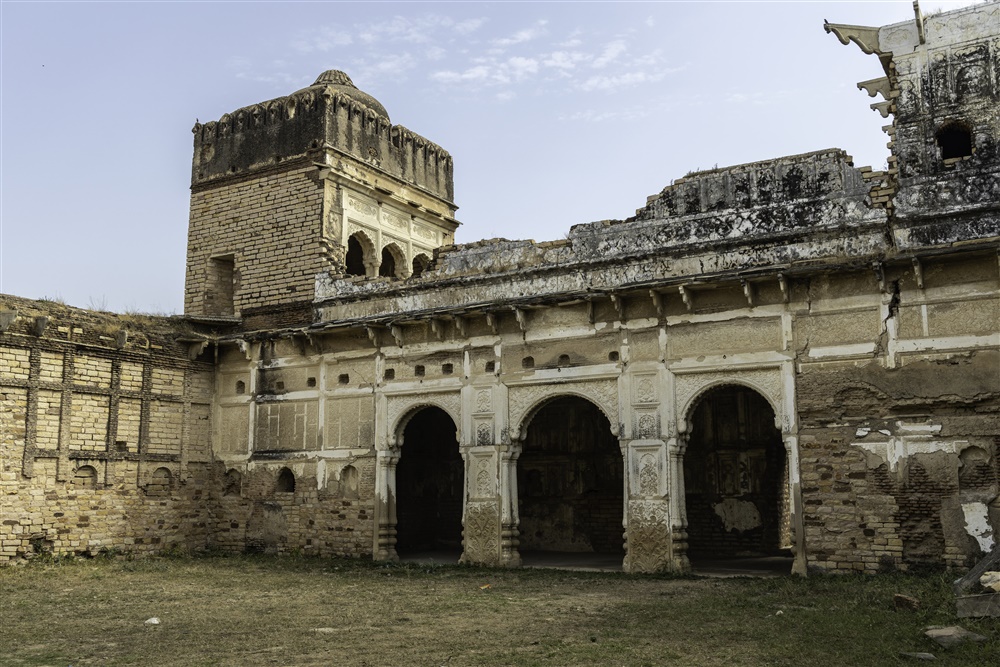
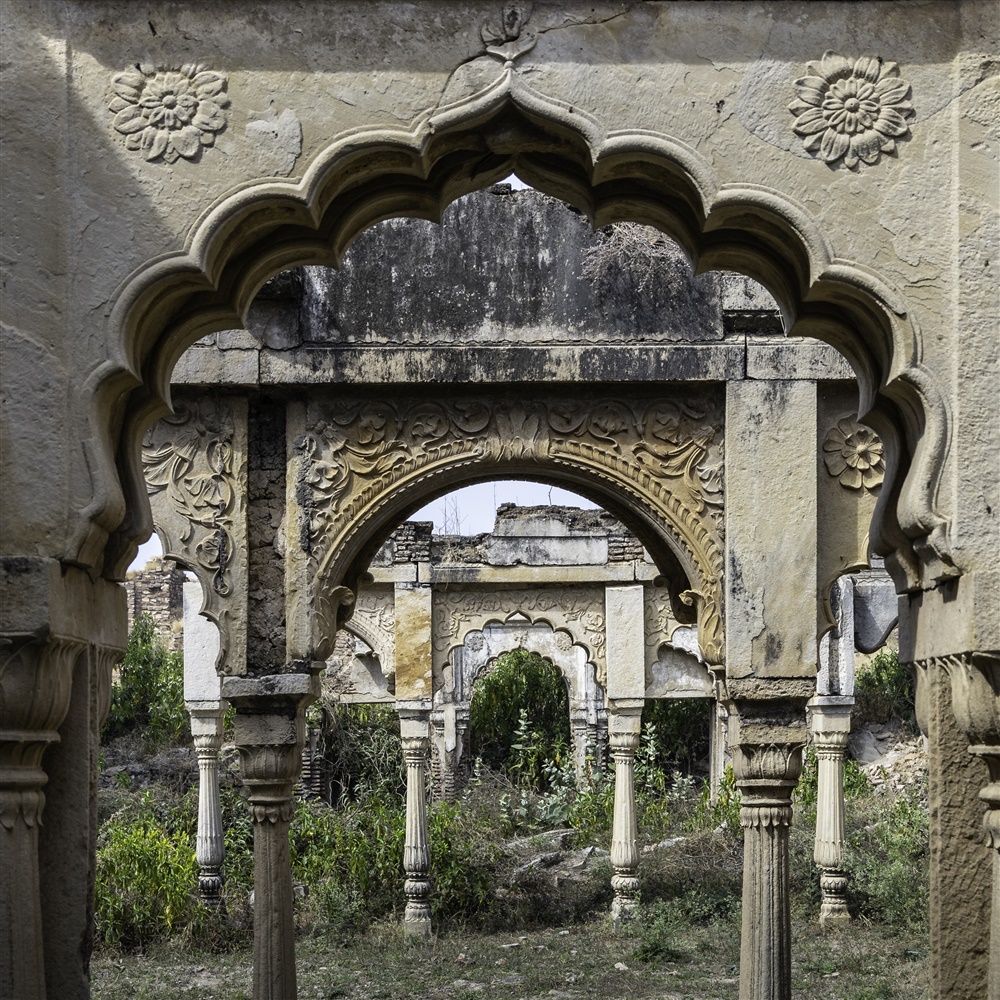

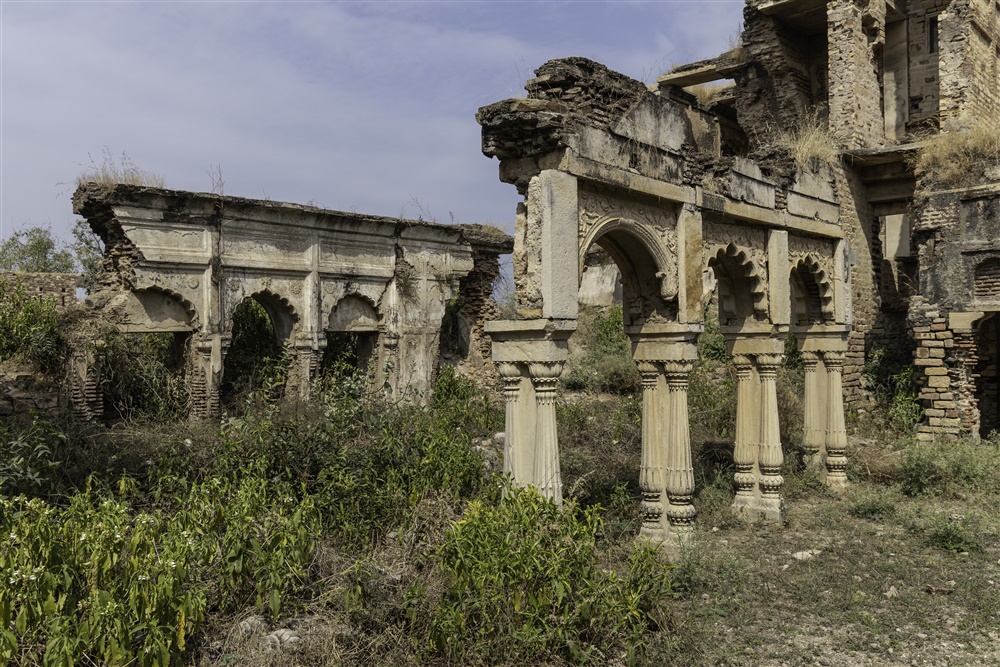




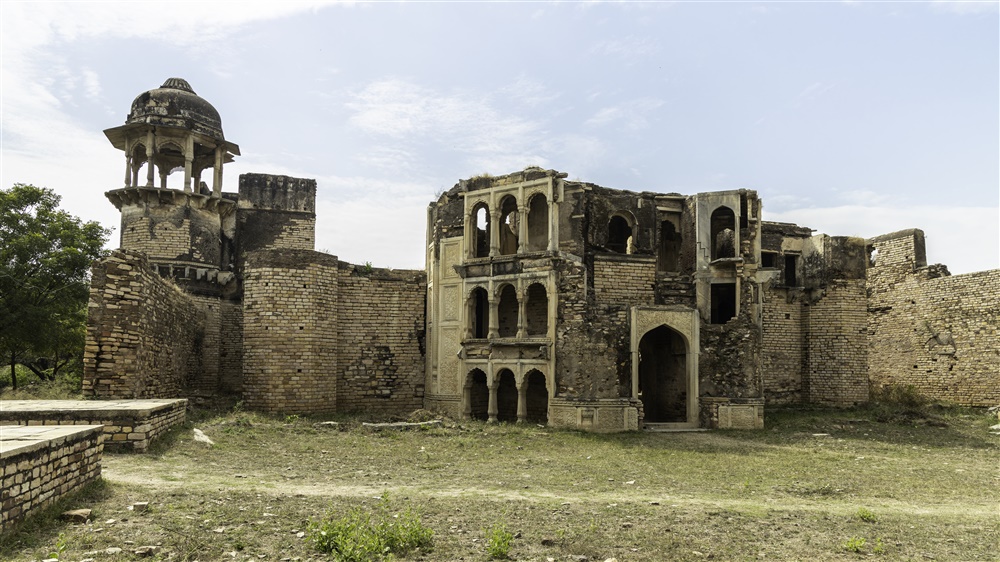









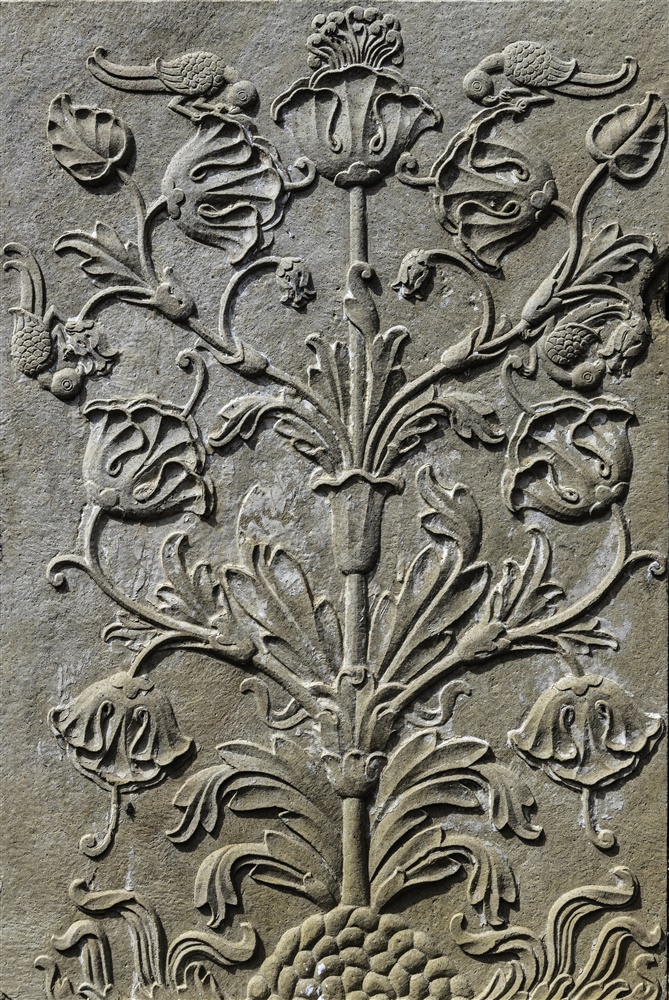



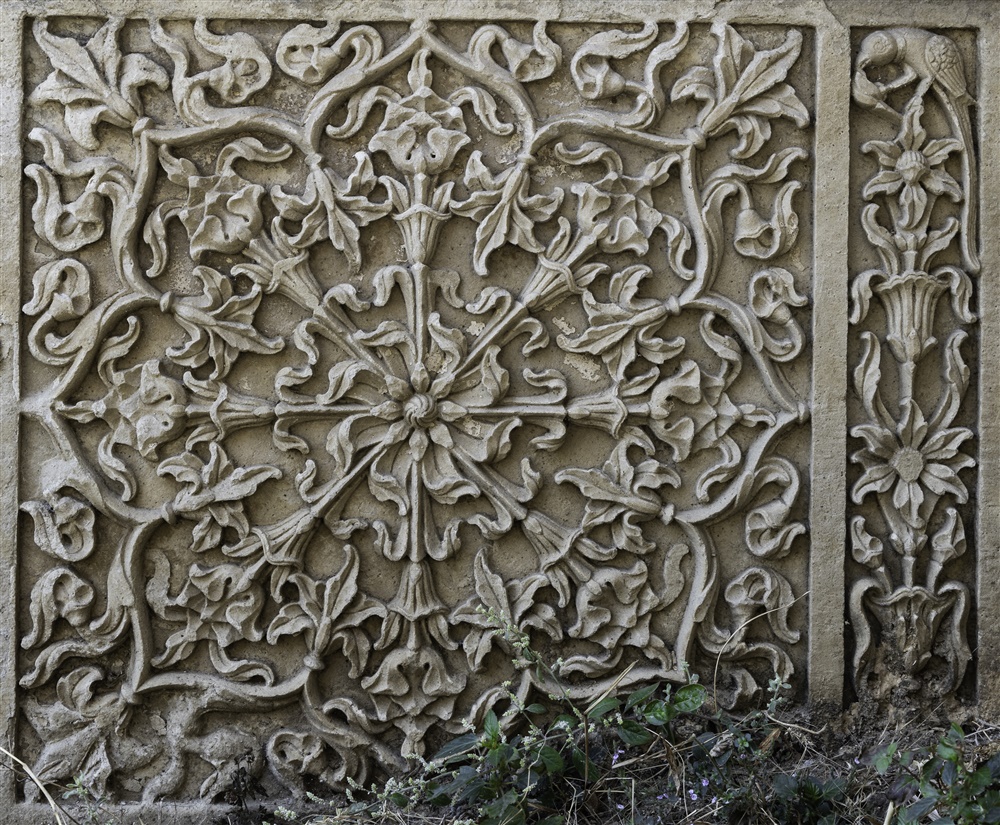







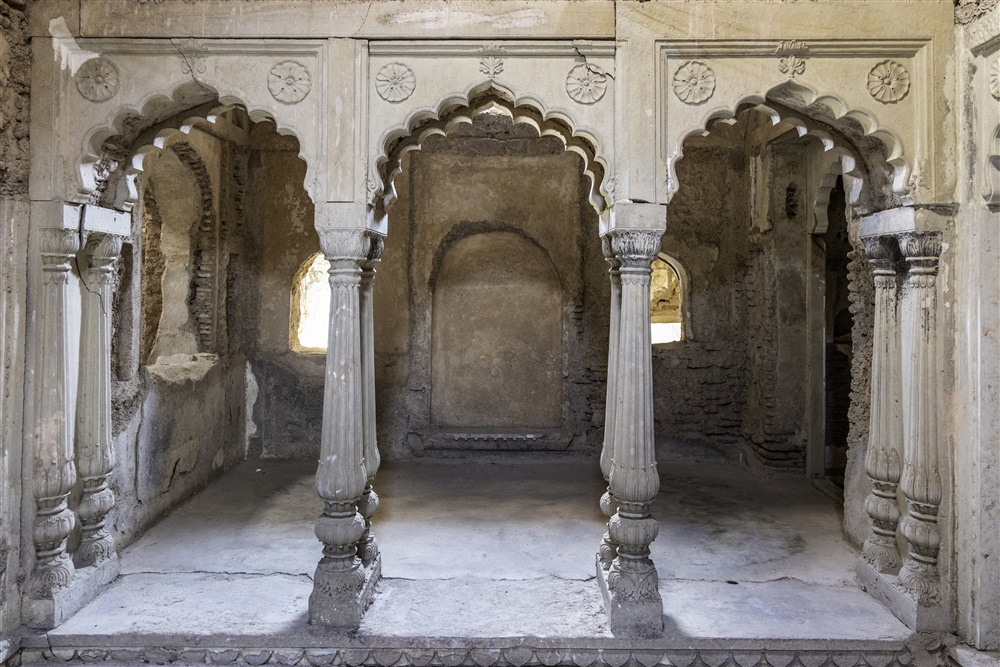
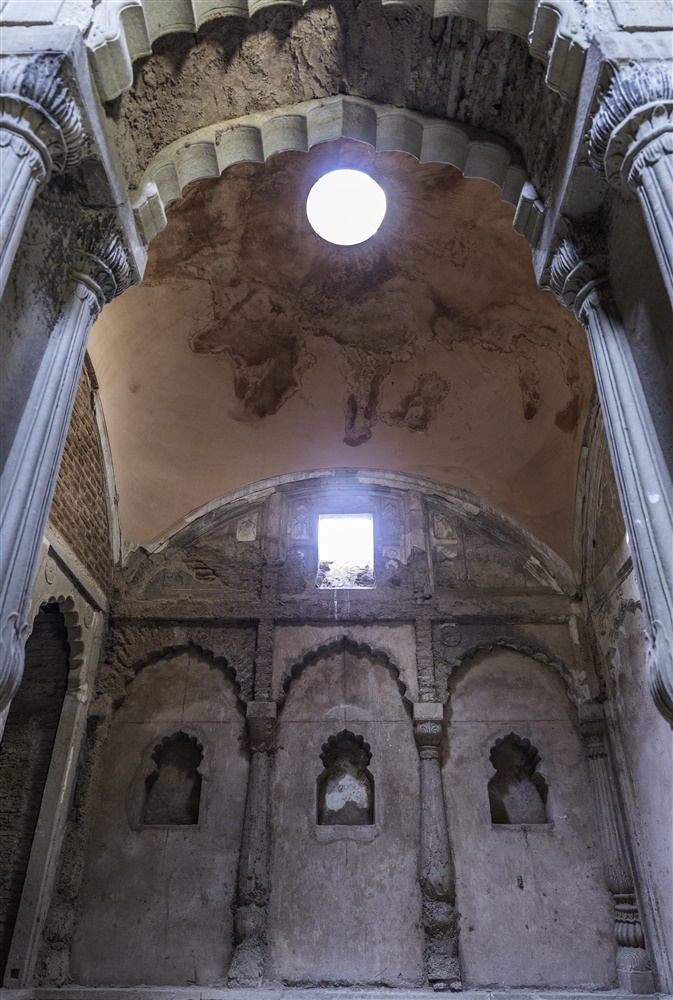


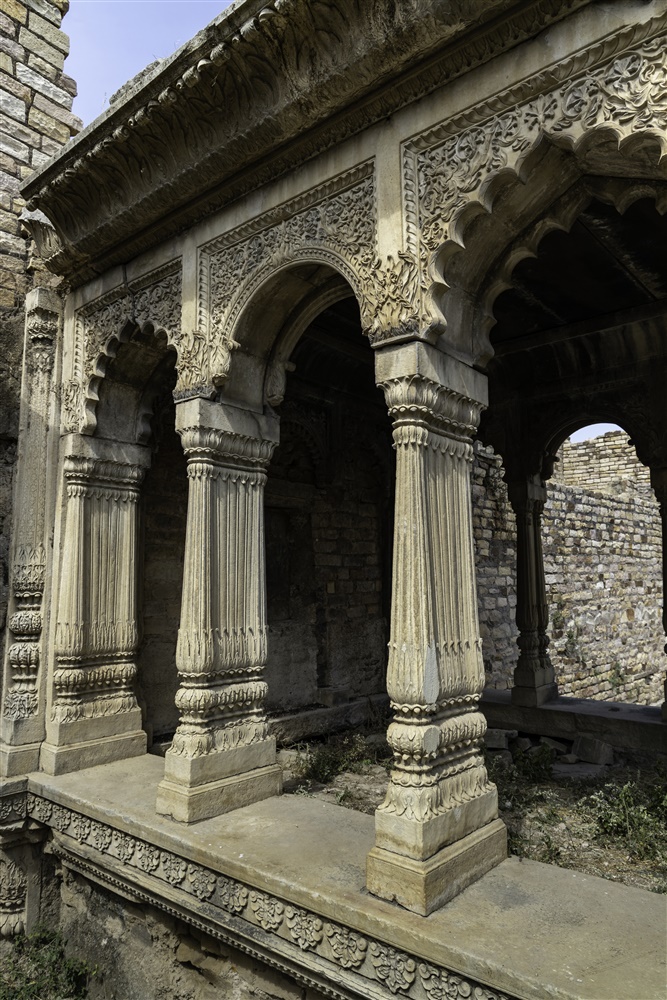

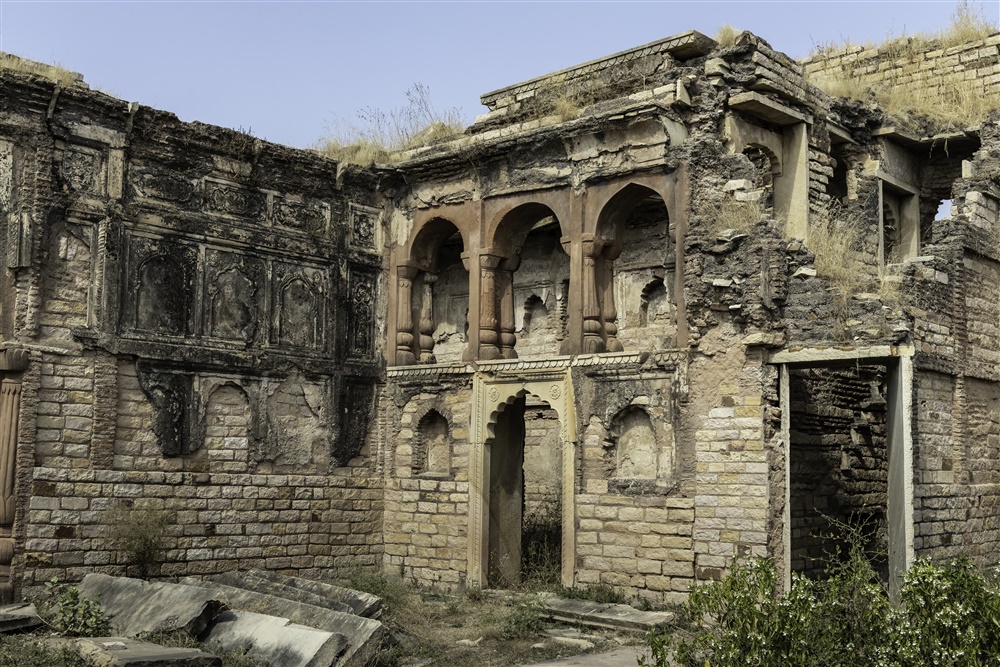


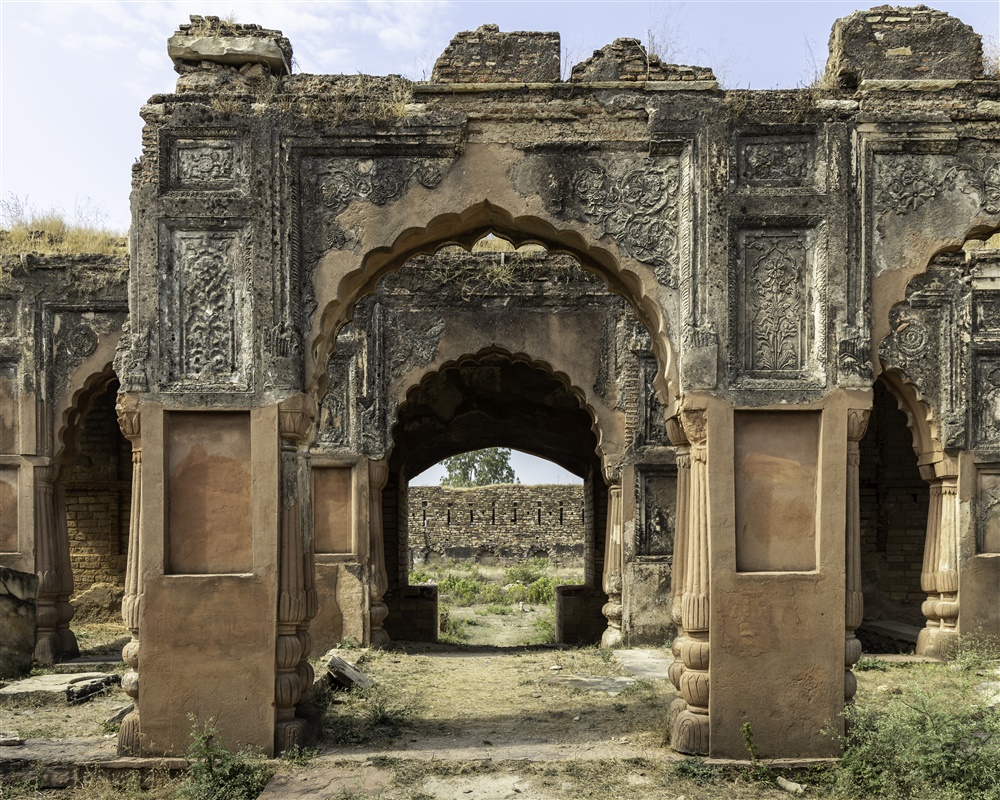
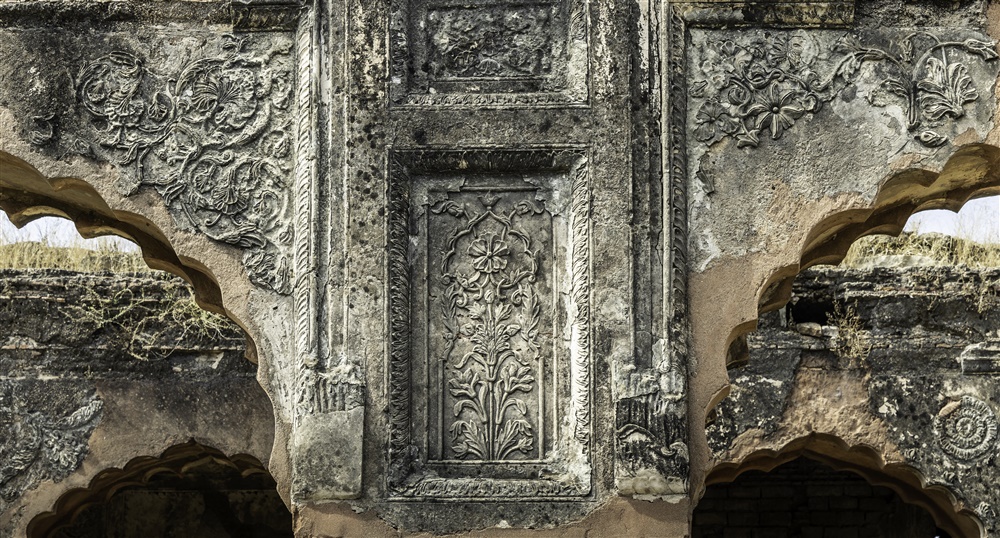


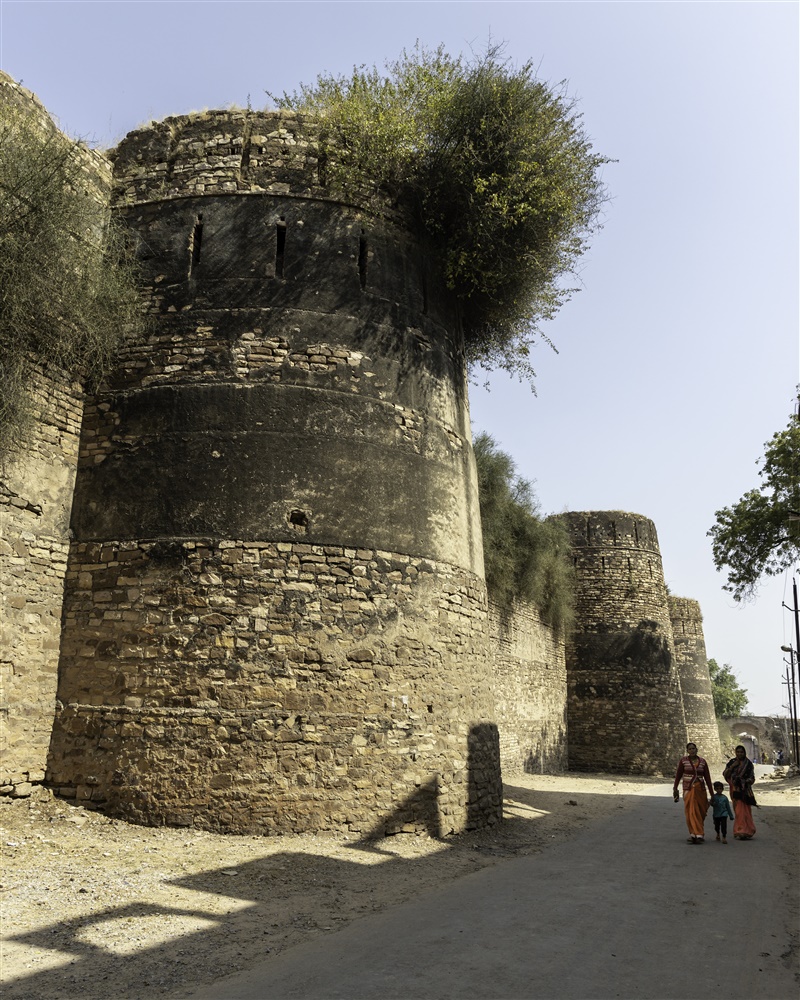



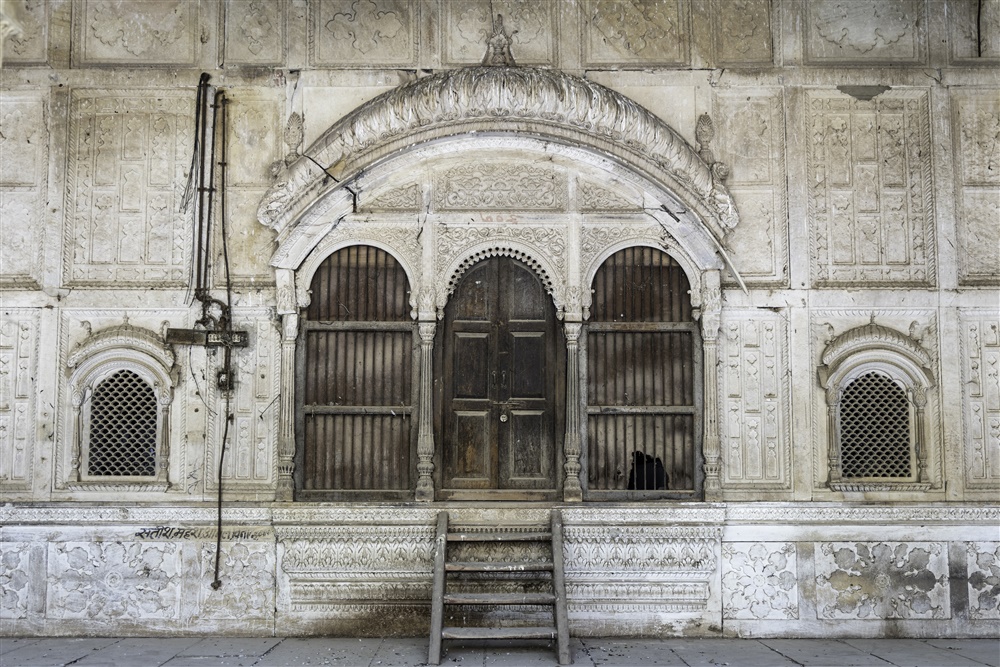




Wow! This is one architectural wonder and much more beautiful than Gandikota fort in Andhra Pradesh which is one I visited. Loved your photos, will share on facebook. This blog post is a keeper! Bravo to the architects and builders and to your good self for sharing it with us.
LikeLiked by 1 person
Places like this should be visited more, the local economy would really welcome it too !
LikeLiked by 1 person
I agree Kevin these are real treasures!
LikeLiked by 1 person
1800 Old Photo of Laxman Taal in Gohad Fort by British General :
http://www.bl.uk/onlinegallery/onlineex/apac/photocoll/t/largeimage65229.html
LikeLike
Photo by British General :
http://www.bl.uk/onlinegallery/onlineex/apac/photocoll/t/largeimage65229.html
LikeLike
Few Good Photos Gohad : http://yogeshmp.blogspot.com/2017/07/blog-post_10.html
LikeLiked by 1 person
Thank you Raj, very much enjoyed.
LikeLike
Thanks for your keen observation – I noticed 3 great things – One is awesome Colored Paintings, Great Design Entrance Gates and Central Courtyard for Festival Celebrations. Totally Amazed. Architecture is more Persian more like Agra Fort, Red Fort Gates. Not sure which one was constructed 1st.
LikeLike
Wonderful exploration. There is a dire need of documenting such monuments.. While cities like Delhi, people are getting aware about heritage value of places.. The fort and palaces in coutryside are often ignored just like any other rendom building.
There are infact many more places in chambal region which are in dire need of documentation.
There are forts of Bhadauria rulers in Bhind, Ater and MP and Nuangaun in UP.
There is pre mughal fort deep into chambel revine at a place called Hath Kanth in Jaitpur block in Agra district, just 50 Km from Bamrauli
LikeLiked by 1 person
You’re making me want to go and see these places 🙂
LikeLike
More Good Photos of Gohad : http://yogeshmp.blogspot.com/2017/07/blog-post_10.html
LikeLike
Dear Kevin, the BM photo cannot be considered as Laxman tank view because of presence of rain water. It is agricultural fields. Regards
Ranbir Singh Former Public Relations Officer Indian Council of Medical Research (ICMR), (Department of Health Research, Govt. of India), Ansari Nagar, New Delhi-110 029
Contact No.09416051382 (Mob.)
रणबीर सिंह
*iwoZ tulaidZ vfa/kdkjh*
भारतीय आयुर्विज्ञान अनुसन्धान परिषद् (स्वास्थ्य अनुसन्धान विभाग, भारत सरकार) वी राम्लिंग्स्वामी भवन, अंसारी नगर, नई दिल्ली-११० ०२९
Res. 275, Sector-2, HUDA, Rohtak-124 001 Telephone Nos: 01262-295745 (Res.), 09416051382 (Mob.), 8168956402 Additional E-mail IDs: rsphaugat@live.in,ranbirphaugat@gmx.com,rithalranbir20002000@yahoo.com
LikeLike
I agree. Gwaliar is full of surprises,nearby 64 yogini temple at Maitaoli, Padavali,bateshwar,kakanmath Shiva temple and several others. Orcha has both nature as well as grand arcitecture. No infra and very little preservation.
LikeLiked by 1 person
I visited most of the places you mention, so watch this space for updates on those locations 🙂
LikeLike
Sir- Is it possible for you to convert these Photos as Thumbnail so that we can enlarge them on our system to observe like 3 or 4 of them can be enlarged with Hand Thumb Nail but others are pure simple ones ? That will be of great help to understand more deeply about Persian Architecture. Thanks a lot for your help
LikeLiked by 1 person
Hi Raj, yes this is possible, but not for a few weeks as I am current supervising an archaeological excavation.
LikeLike
I have been twice here and did documentation and photography with ultra wide angle lens.
LikeLiked by 1 person
Sir – can you please post those great photos. Moreover, I am also trying to Map and Digitize the 360 Forts Protecting this Gohad Fort and its uniqueness in the world as 1st ever Laxman(Younger Brother of Lord Ram) Temple anywhere in the world. Architecture is amazing and different from Mughal Style..More Persian Style
LikeLiked by 1 person
This Guy also Did Some Nice Job on Gohad
http://yogeshmp.blogspot.com/2017/07/blog-post_10.html
LikeLike
I didn’t prefer writing a single line and posting a single photograph and sharing for IPR issues. But as you rightly observed it is not much visited. Since I am also a Jat from Rohtak, Haryana, India I have made it a point to visit all Jat strongholds in my life time. But kindly never say that any place had visitors seldom. You never know. There are places in the wilderness along the left bank of the Chambal river beyond Karauli (that I suppose you don’t have visited so far), that are still unknown but people do visit. You are also silent about its architectural details. It is most beautifully laid.In fact, I found it more attractive than Narwar or even Gwalior. You forgot to mention about an octagonal hall that was used for ceremonial purpose when the bride was readied and folk songs were sung on the occasion. You also didn’t mention about a memorial cenotaph nearby and the huge British time water reservoir that provides water supply to town. Didn’t also catch the life in Gohad town that is seemingly straight from an eighteenth century era. You did capture some shots of the New Fort Palace but need to have separated the description. You also didn’t mention as from which place or the nearby quarry the building material was procured. Anyhow your photos are superb.
LikeLiked by 1 person
Thank you for all the comments. I struggled to find any information on the fort which is why there really isn’t much detail, it was the guard/attendant at the fort that said it is not visited very often. I’m also nowhere near qualified to describe the architecture to any extent, in fact my entire blog was originally intended to be focused more on the photography of these places, but over time that’s morphed a little bit because of my interest in archaeology. So it’s not a case of forgetting to add detail, it’s a failure in knowing the detail in the first place. My time at Gohad was also too short, but then that is a good excuse to one day return. I hope that at the very least I can raise a little bit of awareness about places like Gohad Fort.
LikeLike
Kevin – I am in search for 360 Forts which Protect this Gohad Fort for almost 500 yrs and which even Mughal Emperor Aurangzeb dared to attack. I want to digitize this fort..UNESCO also noted this and restoring it to its best level..Foundation was laid around 1475 AD or earlier
LikeLiked by 1 person
Hi Mr Kevin ! Congratulations ! It is a wonderful photography of Gohad Fort. I have compiled some history about Gohad and Gohad Fort. You can see here
https://www.jatland.com/home/Gohad_Fort
https://www.jatland.com/home/Gohad
I could not visit the place. I have learnt that there are 360 Jat Forts around Gwalior. I could list only a few. There is a strong need to search these lost forts and their past glory. If permitted I may add some of these images in above articles. Regards, Laxman Burdak
LikeLiked by 1 person
Thanks for your comments Laxman. Please get in touch with me first if you intend to use any of my photographs.
LikeLike
Kevin’s photographs are laudable but the information posted on Jat land is not acceptable to me. You could not have verified because you did not visit. I paid to visits and examined in detail every corner and wall. There are inaccuracies at many places in mention of facts. Please first go to Gohad, see for yourself and modify this write up. On the other hand Kevin’s write up is accurate.
LikeLike
Sir – Please suggest or advise which information is incorrect or not acceptable to you on Jatland website and why ? 98% of Rajput history is bogus,manufactured and over hyped. Can anyone challenge that ? If a Gang of Historians Collected and say something and put it in books then it become authenticated for future for example Not a Single Book Teaches and not even a single line written anywhere that India won 1965 war with the valor courage and sacrifice of 3 JAT and again 1971 Indo Pak War was a almost a lost one to Pakistan when 2 JAT valiantly & brilliantly turned it around and bring honor respect to India…No Media Speaks or mentions BUT Sadly all Pakistan Top Generals Praised the courage of JAT Soldier and wrote about it(I can provide Proof)..Same is the story about the Killing of Taimur Lung/Lame by Harvir Singh Guliya. Even Mighty Russians were defeated by Taimur but JATS Killed him and forced him to ran away for Battlefield….Lot more and sadly its the truth but Who cares ? All Bogus, War Deserters are great in Books. One more example- Lord Lake was the greatest of great General of the whole British Empire, he never lost a single war, not in Europe and Not in Americas. He had the best, latest, most sophisticated weapons of its time, British Empire Might, and all resources at his disposal .JATS Crushed & Defeated British Empire not once but 13 times..BUT not a single school book even mentions this forgot about teaching..Again Sad but True..All Traitors History is recorded..I can give lot of example like this BUT please point our errors so that those can be verified, validated and posted..Thanks Sir.
LikeLike
Link has more detailed Gohad Photos : http://yogeshmp.blogspot.com/2017/07/blog-post_10.html
LikeLike
No reference is required for own eyes, Mr Kevin. I have asked the administrator of Jat Land, whether he ever visited Gohad Fort. Your point is well taken but let he first respond.
LikeLike
Jatland.com is a community site and its members can add content to it. What is required is that one has to give reference to the content added. I think all content on Gohad is from written records. If Mr Ranvir Singh has more content on Gohad he can send me with references to add. No further explanation is required from the wiki editors. If any photo is required from this blog I will request Mr Kelvin. I hope Ranvir Singh has nothing to do in this matter. Regards,
LikeLike
I didn’t like the last line that I have nothing to do. Of course, it were yourself that had to do and didn’t do. I asked if you ever visited Gohad fort? No reply came forward. I don’t have bad intentions when I pointed out some lacuna or deficiency. Had you cared, the description about Gohad fort would have been more authentic and acceptable. In matters of information modification, arrogance and denial don’t ever help. Mr Kevin Standage has been very nicely replying. The description about Gohad fort had to be re-written and if it continues in its present form, misinformation will compound. In public domain one has to be very considerate because information is seen worldwide. If you read ill-will in my messages, surely I have nothing to do with Jatland or any other thing on Wiki. Peer review is a great thing in the world of publishing, as should be known by everyone.
LikeLike
Sir- Lot of Images are still cannot be enlarged or without Thumbnail BUT I know you are very busy but please just keep my request in consideration, subject to your time. Thanks a lot.
LikeLike
I’m currently away, so you will need to be patient with me…
LikeLike
Sir, I am curious if you have some time now to finish the remaining photo for Thumbnail Conversion so that we can explore and study the actual work. 2 Updates from news articles : Rs 7 Crore Spending and Govt want to bring it for Big Tourist Push :
https://www.bhaskar.com/mp/bhind/news/mp-news-70-renovation-of-gohad-fort-with-rs-7-crore-tourism-will-get-a-boost-072005-5268676.html
and one Sad State of the Glorious gates..They are crumbling and I am writing to WMF again for some funds to protect them :
https://www.bhaskar.com/mp/bhind/news/mp-news-bhim-singh-rana-gauri-sarovar-correspondent-bhaskar-lovers-badan-singh-atar-tourists-shivraj-singh-chauhan-archeology-lovers-rulers-politicians-people-gaur-surai-contractor-representatives-authorities-mahasingh-bhadauriya-jat-scindia-villagers-department-officials-bhim-singh-holkar-chhatri-salvi-gohad-fort-bhind-buildings-lake-district-heritage-sites-building-fort-reservoir-rooms-holkar-chattar-alampur-akalal-city-tourist-destination-napa-municipality-country-atre-fort-museum-area-river-atre-land-ma.html
https://www.bhaskar.com/mp/bhind/news/mp-news-burkhit39s-gate-damaged-in-the-fort-the-danger-to-the-farmers-visiting-the-fields-024131-3864577.html
LikeLiked by 1 person
Hi Raj. I’m currently away from home in Scotland for the next four weeks, so I am not able to do anything at the moment.
LikeLike
I am and will..Thanks
LikeLiked by 1 person
OK. Thanks and Curious if you have a detailed Photographs of “Sheesh Mahal” – Glass Palace or were you able to locate it anywhere ?
LikeLiked by 1 person
Great! There are many such places in central India. Enjoyed reading your blog!
LikeLiked by 1 person
Thanks Moreshwar 🙏 Currently back in India for two months, so much more content coming up from mid March onwards 😀
LikeLike
Thanks for coming to India.
India has so many such hidden unexplored or lesser known forts. Tourists like you are saving these heritage structure. Many monuments in India are struggling for survival due lack of security, facilities, maintenance & public interest. Again thank you sir. Keep exploring
LikeLiked by 1 person
Thanks Rahul. I’ returned to the UK yesterday evening after a further 7 weeks in India, including Varanasi and Bubaneswar, so content on those places will be starting quite soon. Bubaneswar is a very good example of where in some cases the lack of interest and maintenance is very noticeable. I’d like to think in some small way I can raise awareness a little more about these hidden places. In Bubaneswar city alone I visited over 60 temples that are 400+ years old !
LikeLike
Thanks Kevin for shedding light on this marvelous yet undiscovered beauty !! Much appreciate your work! While you were there did you get an idea on when the current restoration efforts will be completed?
LikeLiked by 1 person
Dear Kevin,
You have yourself mentioned at the beginning that your feature is mostly photographic and little text, the reason being you could not find any historical documentation about Gohad. This is a common complaint about Indian monuments. The builders, kings who ruled also were indifferent to leaving some history, records on stone. For example, there is Teli ka Mandir on Gwalior fort, which is a unique building of Gopuram style (of South India ) in whole of North India, but hardly any information about why, who built it.
It can be frustating. Most of the documentation of ancient India is by foreign visitors, starting with Huen Sang, Fahiyan. Tavernier, Ibn Batuta etc. I am a Geophysicist by profession (Oil exploration) and travelled a lot in India’s remote areas,and studied in Gwalior and I feel sorry that I did not photograph the interesting ruins and memories. I am past 85 years now, and these are after thoughts.
I really loved the beautiful photos you have taken. Many thanks……Kashinath Bhave
Gwalior state of Scindias had an Architecture Department in 1920s and had documented some very old sculptures near Gohad, some 1500 years old. Sadly I have lost the book.
LikeLiked by 1 person
Dear Kevin,
Firstly, I am very grateful for the extensive research, depiction and photos shared by you in as much detail as possible for the common people.
I am an Architect by profession and also have a keen interest in archaeology along with exploring the hidden gems of India.
I have been visiting Gwalior every year but was not aware of Gohad Fort. Fortunately, I came across your page on Instagram and your post on Gohad Fort was like a blessing in disguise!
I am going back after exploring Gohad Fort and Palace with significant learnings about the intricate stone and brick architecture of the Jat rulers.
Thank you once again.
Shalin Shah
LikeLike
I feel the number of times one visits an already seen and documented place, more came to be revealed. There are several angles of view and several approaches and every time one cannot reach a site and view it at the point of time it was seen on first instance, second or more occasions. Further, we seldom explore the circumstances and masonry acumen after a design is finalized and don’t see the elements of progressive decay that shaped and disfigured a monument when nature worked on it for several centuries. That slow process, in fact, adds aesthetics to a structure.
LikeLiked by 1 person